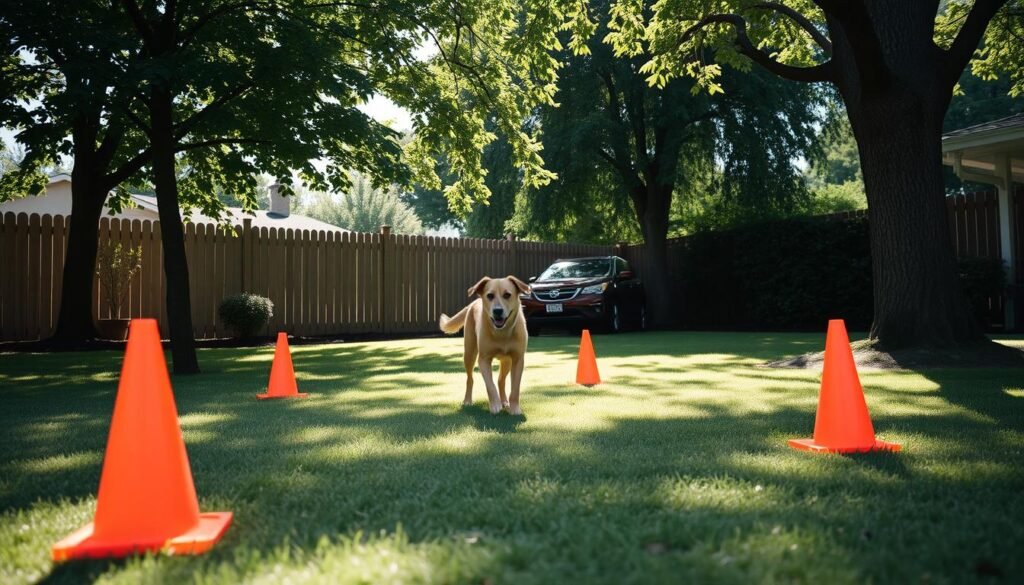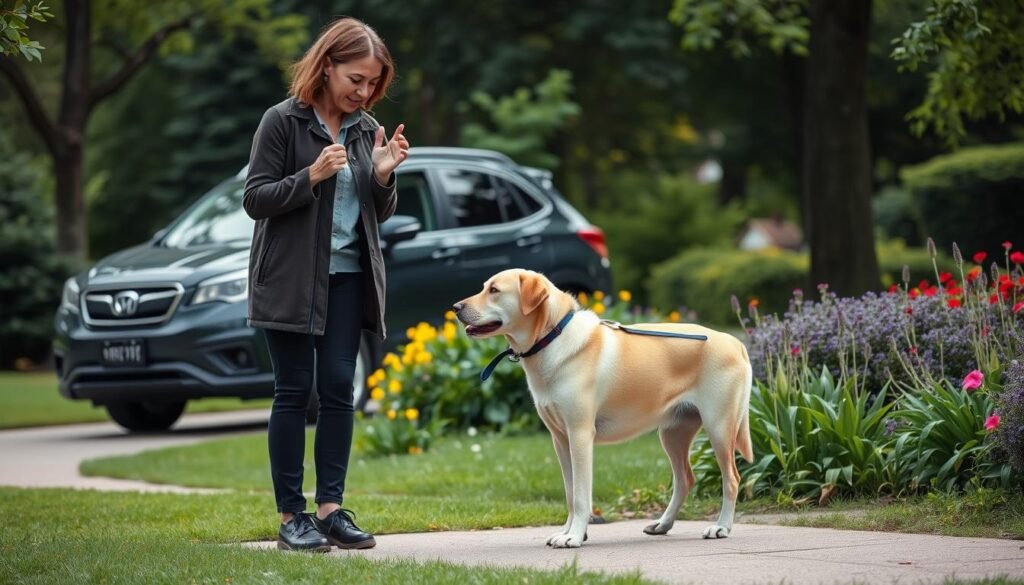Did you know that a staggering 3 months of crating is often required when a dog is hit by a speeding car1? This statistic shows how urgent it is to stop dogs from chasing cars. As pet owners, we must keep our dogs safe. Luckily, the “Dog Whisperer” method has a detailed plan to solve this problem.
Dogs chase cars because of their strong prey drive and instinct2. Knowing why they do this helps us find ways to keep them safe. We can teach them to focus on safer activities instead.
Key Takeaways
- Dogs often chase cars due to a high prey drive and instinctual behavior, putting them at risk of injury or death.
- Effective management strategies, obedience training, and environmental enrichment can help stop this dangerous habit.
- The “Dog Whisperer” approach combines various techniques to redirect a dog’s energy and create a more fulfilling life.
- Socialization and consistent training are key to teaching dogs to focus on their owners and avoid chasing cars.
- Regular exercise and mental stimulation can help reduce a dog’s fixation on cars and redirect their energy in a positive way.
Understanding Your Dog’s Motivation
To stop your dog from chasing cars, you need to know why they do it. Dogs with a strong prey drive and instinctual behavior often chase cars3. Their genetic makeup makes them want to catch moving things, like cars3. Understanding this is key to training them to behave differently.
High Prey Drive and Instinctual Behavior
Some breeds, like herding or hunting dogs, are more likely to chase3. They chase because of their inherited drive and the joy they get from it3. Their genes and the environment can make this behavior worse3.
Knowing why your dog chases cars is important for fixing the problem3. By understanding their dog’s chase response and what triggers it, you can train them better. You can teach them to find other, safer ways to satisfy their instincts.
“The herding breeds are mentioned as displaying specific parts of the ‘predatory sequence’ quite strongly due to selective breeding practices over the years.”4
Scolding dogs for chasing can make them more anxious and trigger the behavior3. Instead, change their environment, reduce stress, and give them new targets to chase3. Training them to chase something else can take a few months3. But, if you understand and address their motivations, you can help them change.
By understanding your dog’s genetic and instinctual factors for chasing cars, you can create a training plan. This plan will help redirect their energy and give them better ways to express their predatory tendencies.
Management Strategies
Stopping your dog from chasing cars starts with good management. You need to set up physical and invisible barriers. This keeps them away from cars. Using baby gates, leashes, and “wait” commands helps control their space5. This way, you can prevent bad behavior and start training.
Creating Boundaries and Invisible Barriers
Setting boundaries is key to keeping your dog safe from cars. Baby gates can block off rooms or areas near the door or street6. Leash training lets you control where your dog goes, stopping them from running out. The “wait” command teaches them to stay put until it’s okay to move.
Environmental control is also important. Tools like motion-activated alarms or sprinklers can keep your dog away from the street5. These invisible barriers help manage your dog’s behavior, making training easier.
| Management Technique | Description |
|---|---|
| Baby Gates | Physically block access to areas near the street or front door |
| Leash Training | Maintain control over your dog’s movements and prevent dashing |
| “Wait” Command | Reinforce the idea that your dog must remain in a safe space |
| Environmental Deterrents | Use motion-activated alarms or sprinklers to discourage approaching the street |
Using these strategies together can stop your dog from chasing cars. It’s a great start to successful training56.

Obedience Training: Essential Commands
Obedience training is key to stopping your dog from chasing cars. Focus on commands like “come,” heel, and “leave it” to address this issue7. A strong recall lets you call your dog back right away if they get too close to a car. The heel command teaches them to walk by your side without chasing cars. The “leave it” command tells them not to chase cars, even when you’re not there.
Training should be consistent and positive to build these skills7.
Reliable Recall and “Come” Command
The “come” command is the base of a reliable recall. It’s vital for stopping your dog from chasing cars. With regular training, your dog will learn to come back to you quickly, even when they see cars moving7.
Practice often and use rewards to help your dog learn this important skill8.
Heel and “Leave It” Commands
Learning the heel command is also critical. When your dog walks by your side calmly, they’re less likely to chase cars7. The “leave it” command teaches them that chasing cars is wrong, even when you’re not there. This helps them ignore distractions and focus on you instead, improving their behavior7.
Using these commands, along with positive training and regular practice, can greatly help your dog stop chasing cars7. Training puppies is often easier than fixing adult dogs with this habit. So, start training early for the best results7.

how to stop a dog from chasing cars dog whisperer
As a “dog whisperer,” we understand that stopping a dog from chasing cars is complex. It involves addressing the reasons behind this behavior9. Dogs chasing cars can get hurt or hurt others9. They might even fall, which is more dangerous for big dogs9.
Dogs who chase cars might start chasing people on skateboards or bikes too. This makes them a bigger risk of biting9.
10Chasing cars is natural for some dogs, but for others, it’s learned. This behavior stresses out dog owners10. We use dog whisperer car chasing techniques, dog whisperer car chasing training, and dog whisperer car chasing methods to help. These methods tackle your dog’s prey drive, lack of fulfillment, and environmental factors.
- Management Strategies: Use a short six-foot leash near roads to keep dogs away from cars9.
- Obedience Training: Teach your dog to obey commands like “come,” “heel,” and “leave it.” This helps you control them and keeps them from chasing cars.
- Environmental Enrichment: Give your dog enough exercise, mental challenges, and safe ways to chase, like lure coursing or fetch. This can lessen their urge to chase cars.
With a full dog whisperer car chasing solutions and dog whisperer car chasing tips, you can stop your dog from chasing cars. This keeps them safe10.

Getting help from a dog behaviorist and using positive training are key. Building a strong bond with your dog is also vital in stopping car-chasing behavior10.
Providing Fulfillment
It’s key to meet your dog’s physical and mental needs to stop car chasing. A dog that’s active and mentally sharp is less likely to cause trouble11. Training and exercise can cut down on car chasing11. Also, mental games and puzzle toys can lessen the urge to chase11.
Exercise and Mental Stimulation
Dogs need daily walks, play, and training to satisfy their instincts11. Teaching them to listen and obey can steer them away from danger11. Professional training can also tackle car chasing issues11.
Activities that challenge their minds, like puzzles or tricks, can keep them busy and happy11. Blue Heelers, for example, were bred to herd and love it12. They’re at their best when they’re working12.
Dogs, like Blue Heelers, have natural behaviors they must fulfill to be content12. Just as humans chase goals that may not truly satisfy, dogs do the same12. Understanding this can help us address car chasing in dogs12.
“Delight yourself in the Lord, and he will give you the desires of your heart.” (Psalm 37:4)
This verse reminds us to aim for meaningful goals, a lesson for humans and dogs alike12.
Desensitization and Controlled Exposure
Gradually exposing your dog to cars in a controlled setting can help them get used to it. This method involves starting with stationary or slow-moving cars. Reward your dog for staying calm and focused on you13.
As your dog becomes more comfortable, you can increase the exposure level. Always keep control and use positive reinforcement13.
Desensitization and controlled exposure teach your dog that cars are not threats. This prevents dangerous chasing behaviors1314. It’s great for dogs with high prey drive, like sighthounds and German shepherds13.
The success of desensitization depends on working under your dog’s threshold. Gradually introduce car stimuli while rewarding calm behavior14. This makes your dog associate cars with positive things, not fear or excitement14.
Identify and address any stress signals in your dog during training. This ensures the exposure is not too intense14.
Habituation and counter-conditioning are effective for training dogs around moving objects. Start with car sounds and sights indoors, then move outside with closer proximity1314. Reward your dog for checking in with you after seeing cars14.
Patience and consistency are essential in desensitization and controlled exposure training14. The process may take time. Make sure your dog stays under threshold to avoid stress14.
Regular practice and maintenance sessions are key to solidifying the learned behavior. This prevents the chase instinct from returning15.
By gradually exposing your dog to cars in a controlled and positive way, you can desensitize them. This prevents dangerous chasing behaviors1314. This training, along with other strategies and obedience commands, keeps your dog safe and under control around vehicles131415.
Conclusion
We’ve looked at how to stop dogs from chasing cars. We found ways to understand and manage their behavior. This helps keep them safe from danger.
Teaching dogs to obey commands like “leave it” is key. It helps them know what to do when they see cars. Also, keeping them busy and happy can stop them from chasing cars.
Using “Dog Whisperer” methods helps a lot. These include training plans and positive rewards. They help dogs learn to stay away from cars. This way, our dogs can live safer and happier lives.
FAQ
What are the common reasons dogs chase cars?
How can we create boundaries and prevent our dog from accessing the street or cars?
What are the essential obedience commands to stop a dog from chasing cars?
How can the “Dog Whisperer” approach help stop a dog from chasing cars?
How can we ensure our dog’s physical and mental needs are met to prevent car chasing?
How can we desensitize our dog to cars and reduce their car-chasing behavior?
Source Links
- Q & A: How Can I Stop My Dog From Chasing Cars? – Thriving Canine – https://www.thrivingcanine.com/blog/stop_dog_chase_cars/
- How To Stop Dog Chasing Cars The Easy Way! | AwokenK9.com – https://awokenk9.com/how-to-stop-dog-chasing-cars/
- Why Do Dogs Chase? Understanding Their Drive (Plus How to Control It) – Dogster – https://www.dogster.com/dog-behavior/why-do-dogs-chase
- Car Chasing – Whole Dog Journal – https://www.whole-dog-journal.com/blog/car-chasing/
- Successfully training a dog not to chase cars or anything else – https://thelightofdog.com/successfully-training-a-dog-not-to-chase-cars-or-anything-else/
- Why do collies chase cars? And what can I do about it? – https://collieconsultant.co.uk/2023/09/24/why-do-collies-chase-cars/
- Training your dog not to chase cars – Vetwest Veterinary Clinics – https://www.vetwest.com.au/news/training-your-dog-not-to-chase-cars/
- Free Tips on How to Stop a Dog from Chasing Cars – https://www.doggoneproblems.com/dexter-stop-chasing-cars/
- No title found – https://www.akc.org/expert-advice/training/prevent-dog-chasing-cars/
- How to Stop Your Dog From Chasing Cars – https://www.webmd.com/pets/dogs/why-do-dogs-chase-cars
- Dogs Chasing Cars: Understanding and Addressing the Behavior – Hot Dog on a Leash – https://hotdogonaleash.com/dogs-chasing-cars-understanding-and-addressing-the-behavior/
- Chasing The Wrong Things | The Porch – https://www.theporch.live/blog/chasing-cars
- Dog problems: car chasing – Woof Like To Meet – https://www.woofliketomeet.com/2019/02/dog-problems-car-chasing/
- Ask Crystal: Advice on Chasing Cars – Blue Ridge Humane Society – https://www.blueridgehumane.org/chasing-cars/
- PDF – https://www.oregonhumane.org/wp-content/uploads/8.2.17_Your_Chase_Driven_Dog.pdf
